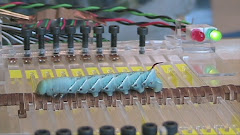
Folks in the field of animal locomotion would know how kinematics data are usually obtained. But allow me to summary the general procedure in a few sentences. To track anything in 3D, at least two camera views have to be available at all time. After space calibration, one can calculate the 3D configurations of the objects in the analysis software of his/her choice. Ideally, video tracking can use any inherent features of the subject. However, to facilitate automatic tracking, high contrast makers are often attached to the subject. Infrared markers offer a way to highlight the features of interest without compromising the lighting for the normal video acquisition. After I created two families of soft-bodied robots, I was challenged by the need of quantitative data. These kinematics data are critical for any mechanical analysis on the robot locomotion.

I set up our VICON 3D system to track my robot kinematics at Tufts Advanced Technology Laboratory. VICON is a company that makes 3D tracking systems for research in locomotion and animation industry. It employed several near infrared high speed cameras which would detect the IR signals coming off the retro-reflective markers attached to the subject. Unfortunately, retro-reflective marking is really not the way to track small animals such as insects or robots of the same scale. After going through many types of IR florescent chemicals, I finally decided to go with semi-conductor IR emitters (or infrared LEDs).

This works out really great for my application because I do not need to worry about IR light flooding or bad camera focus. These surface mount IR emitters produce point-source lighting smaller than 1mm. The IR cameras pick them up like many distant stars. In fact, a little out of focus actually increase the pixel numbers from which the centroid positions are derived.

Data are coming alright, but my data crunching techniques are still too slow for the rate by which these high speed cameras acquire data. I better work on that!
 Folks in the field of animal locomotion would know how kinematics data are usually obtained. But allow me to summary the general procedure in a few sentences. To track anything in 3D, at least two camera views have to be available at all time. After space calibration, one can calculate the 3D configurations of the objects in the analysis software of his/her choice. Ideally, video tracking can use any inherent features of the subject. However, to facilitate automatic tracking, high contrast makers are often attached to the subject. Infrared markers offer a way to highlight the features of interest without compromising the lighting for the normal video acquisition. After I created two families of soft-bodied robots, I was challenged by the need of quantitative data. These kinematics data are critical for any mechanical analysis on the robot locomotion.
Folks in the field of animal locomotion would know how kinematics data are usually obtained. But allow me to summary the general procedure in a few sentences. To track anything in 3D, at least two camera views have to be available at all time. After space calibration, one can calculate the 3D configurations of the objects in the analysis software of his/her choice. Ideally, video tracking can use any inherent features of the subject. However, to facilitate automatic tracking, high contrast makers are often attached to the subject. Infrared markers offer a way to highlight the features of interest without compromising the lighting for the normal video acquisition. After I created two families of soft-bodied robots, I was challenged by the need of quantitative data. These kinematics data are critical for any mechanical analysis on the robot locomotion. This works out really great for my application because I do not need to worry about IR light flooding or bad camera focus. These surface mount IR emitters produce point-source lighting smaller than 1mm. The IR cameras pick them up like many distant stars. In fact, a little out of focus actually increase the pixel numbers from which the centroid positions are derived.
This works out really great for my application because I do not need to worry about IR light flooding or bad camera focus. These surface mount IR emitters produce point-source lighting smaller than 1mm. The IR cameras pick them up like many distant stars. In fact, a little out of focus actually increase the pixel numbers from which the centroid positions are derived. Data are coming alright, but my data crunching techniques are still too slow for the rate by which these high speed cameras acquire data. I better work on that!
Data are coming alright, but my data crunching techniques are still too slow for the rate by which these high speed cameras acquire data. I better work on that!

.jpg)
No comments:
Post a Comment